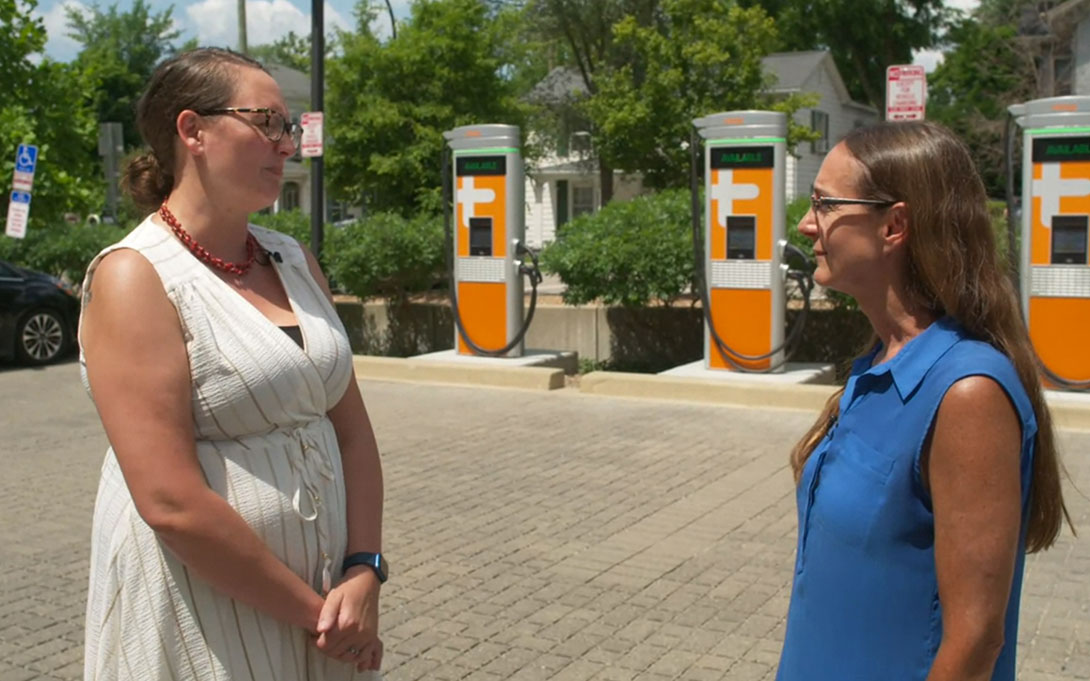
Liz Gerber sees key role for governments in the transition to electric vehicles
The Biden administration wants electric vehicles (EVs) to comprise fifty percent of new vehicle sales in just six years. This has required massive investment in our charging infrastructure. And charging is not the only issue raised by the government’s ambitious, if laudable, goal.
In Ann Arbor, we hear a lot about autonomous vehicles (AVs), the development of which continues apace on U-M’s North Campus. But the inability of self-driving cars to make consistent do-or-die decisions (quick—spare the driver or the pedestrian?) has dampened enthusiasm. Down at the corner of State and Hill, Professor Elisabeth Gerber, who has conducted research on both AVs and EVs, is advocating for the latter. Her research asks, among other things, how local government decision-makers decide whether and how to invest in EV infrastructure.
“Range, range, range,” is the issue with EVs, Gerber says. Depending on the type of charger, ten hours of charging lets you drive about 100-300 miles. The country has some 53,000 public charging stations (you may also charge at home). The states are now getting $5 billion from the Biden administration, as part of the National Electric Vehicle Infrastructure (NEVI) program, to build charging stations on or near major arteries. The first NEVI funded station in the country began operation at a Pilot Travel Center off Interstate 70 near London, Ohio, just west of Columbus, in December 2023.
The public sector must play a role. private companies will invest in wealthy areas, not low-income communities where people may need to drive longer distances."
Elisabeth Gerber
“The public sector must play a role,” says Gerber. “Private companies will invest in wealthy areas, not low income communities where people may need to drive longer distances.”
EV drivers with low incomes will need other help as well. EVs cost about 40% more than their internal combustion counterparts. The federal government is offering subsidies, but only for less expensive models that are American made. Finally, EV batteries have a lifespan of about 100,000 miles. The used car market is a crucial resource for lower income people, but an EV offered secondhand will eventually need a new battery, costing $5,000–$28,000. Should the burden fall on the buyer or the seller or both?
“It’s all about equity,” Gerber says. “Rural folks must be able to own, operate, and charge vehicles in ways responsive to where and how they live. Policy can help expand benefits and create a more equitable impact of EV technology.” The Department of Transportation’s Charging and Fueling Infrastructure [CFI] grant program is making sure public money goes to communities that normally would not get private investment. Still, there is a barrier; those communities must be able to write a federal grant proposal, which is not easy.
“EVs are more an urban/suburban phenomenon right now,” Gerber admits. Ann Arbor, not surprisingly, is well positioned, with chargers on utility poles, in parking lots and decks, and in the lot behind City Hall, where you pay by the kilowatt hour. If you charge at home, the cost depends on where you live and when you charge. “Electricity is more expensive at night,” Gerber points out, “and is much more likely to come from coal-fired plants.”
While the ifs, ands, and buts are many, Gerber says, “I am an optimist. We can do good things with policy. With NEVI and CFI, we’ve already got examples of policy creating a more equitable impact of EV technology.”
Written by David Pratt
